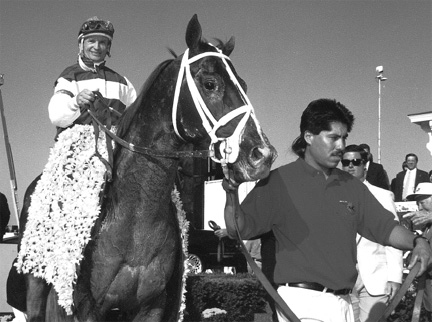Black-eyed Susan Blanket

It remains a long-standing tradition to present the winner of
the Preakness a blanket of Black-Eyed Susans, which is draped
across the shoulders of the winning
horse.
Colonel Edward R. Bradley's Bimelech in 1940 was the first
winner to wear the floral blanket of Black-Eyed Susans.
Construction of the blanket has varied in method from a loosely
intertwined garland of flowers tied with hemp rope, to the
current blanket type of presentation.
The current Black-Eyed Susan blanket is created shortly before
Preakness Day. Three ladies work full-time for two days to
complete the project. The blanket is
composed of more than 80 bunches of Viking daisies. A perforated
spongy rubber matte is used as the base.
Attached to this matte is a layer of greenery. The flowers are
strung together on flocked wire and interwoven into the holes in
the matte.
This makes the flowers and the matte flexible. The ends of the
wire are snipped closely and the whole back of the blanket is
covered with thick felt, so it will lay
softly on the winner's withers.
The blanket is 18 inches wide and 90 inches in length.
Upon completion, the center of the daisies are daubed with black
lacquer to recreate the appearance of a Black-Eyed Susan. The
blanket is then sprayed with water and refrigerated until
Preakness Day, when it is delivered to the track,to be worn by
the Preakness winner. Black-Eyed Susans, declared the state
flower by the
Maryland legislature in 1918 and the Preakness flower in 1940,
do not bloom until June in Maryland. It is said the Susan's
flower usually has 13 petals, which is
taken to symbolize the 13 original colonies, of which Maryland
was one. The flower reproduces the state's black and yellow
colors.

